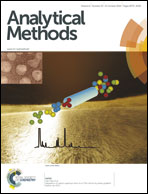The relevance of the analytical methodology in the geochemical study of beachrock outcrops: Arrigunaga Beach inside the Nerbioi-Ibaizabal estuary (Getxo, Basque Country)†
Abstract
Beachrocks are sedimentary structures derived from the precipitation of carbonates in the intertidal zone. Because of this cementation process, they can involve a significant variety of grain types within their structures. This is the case for beachrock outcrops located in the vicinity of the Nerbioi-Ibaizabal estuary (Getxo, Basque Country), an area highly influenced by industrialization. Concretely, a vertical beachrock outcrop located in Arrigunaga Beach, in the inner part of the mouth of the estuary, was studied using a novel analytical methodology to simplify and understand the heterogeneity of the deposits. First, a granulometric separation was carried out followed by the optical microscopic inspection of the fractions and their Raman spectroscopic analysis, revealing the probable heterogeneity of the main beachrock constituents (carbonates and metallic compounds) in each fraction. The total carbonates (acid–base back titration) and the acid-extractable elements (ICP-MS) were quantified, followed by chemometric analyses (correlation analysis and principal component analysis). The combined use of these conventional techniques was particularly relevant for concluding that although the main elements were Fe, Ca, Mg, Mn, Al, Na and K, the key point lies in their distribution in different particle sizes. Indeed, heavy metals, particularly Fe, were accumulated in the 75–250 μm fraction, in contrast to a higher content of carbonates and Ca in the <75 μm fraction. The fact that heavy metals were more concentrated in the coarser fraction led us to believe that an external income of these elements existed, which is likely to come from industrial wastes. Furthermore, the complementarity of the techniques used corroborated the isolation of cements in the finest fraction. Thus, the analytical methodology proposed here helped in distinguishing anthropogenic elements from those comprising the cements, suggesting that both the trapped materials and the components responsible for the cementation occurred in this temperate latitude.


 Please wait while we load your content...
Please wait while we load your content...